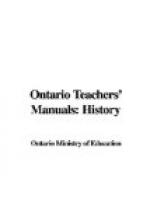P.—If
there was war, soldiers from the United States might
come
over and wreck the railway.
They might dynamite the bridges or tear
up the rails.
T.—As
a matter of fact, they did not take that way.
What route
could be taken to prevent
any trouble of that kind?
P.—They would stay as far from the border as possible.
T.—Where would that be? (Pupil comes to the map to find out.)
P.—They would have to follow the St. Lawrence for some distance.
T.—How far?
P.—Right
down to the other side of New Brunswick. Then
down to
Halifax.
T.—Would that be the cheapest line to build?
P.—It would cost more, because it is longer than the others.
T.—It
is really 138 miles longer than the next shortest.
Which
of the reasons we have
mentioned would make them want to keep as
far from the border
as they could?
P.—The military reason.
T.—Which
country, Canada or Britain, would be the most
interested in the military
considerations?
P.—Britain, because Canada depended on her for protection.
T.—Is
there any other reason, one connected with the cost?
Where
would the money come
from?
P.—Britain would likely have to supply a good part of it.
T.—Why?
P.—Because there were not very many people here then.
T.—Yes, we have to borrow a good deal of money for such purposes even yet. The British Government was to supply the money for the railway, and would want to have something to say as to where it was to be built.
The pupils could now be asked to discover from the map the chief places on the line of the railway. Have them written on the board. The teacher would add some information about the length of the line (1,450 miles), and the total cost ($80,000,000). He might also refer to the fact that the fear of war that caused that route to be followed was not realized, that the Intercolonial did good service in bringing the provinces closer together, and that other railways have since been built on the two rejected routes, namely, the Canadian Pacific Railway and the Grand Trunk Pacific.
The facts of the lesson should then be gone over again, following the black-board outline that has been made as the lesson proceeds.
BLACK-BOARD OUTLINE
1. Provision in
the British North America Act for the building of
the road
2. Reasons for building the road
(a)
Military
(b)
Commercial
3. Selection of the route




